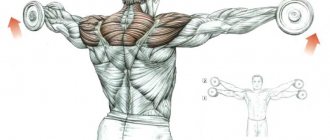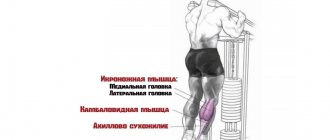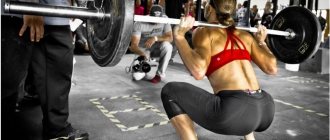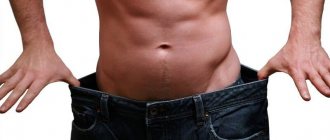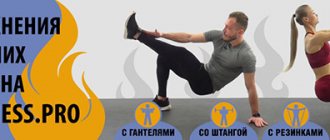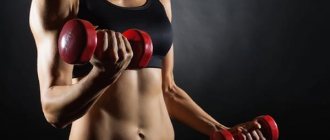What is a dumbbell fly?
A relatively popular exercise among exercises for developing back muscles. Unfortunately, it has a controversial negative side due to the complexity of implementation. The athlete must concentrate as much as possible to engage non-target muscles. In fact, visiting any gym you can see that this exercise is performed, but everyone does it in their own way.
This note is one of the mechanisms for building a big back. Here we will learn how to do the right thing to grow exactly those muscles that are shown in the picture. Let’s not go into the advice of amateurs, but rather let’s see how real professionals do it.
The rear deltoid is the poorest muscle that lags behind all the time. She was one of the three who received a negative load. Few people know, but it helps you bench press, perform different variations of bench presses, and much more.
Photo instructions for muscle loading
Therefore, by performing dumbbell flyes, you will strengthen lagging muscles and improve strength performance. The back of the muscles will become more muscular and developed.
So, the muscle mass of the rear delts forms the prerogative in this way:
- The main task is to pump up the rear and middle deltoid muscles;
- Additional – rhomboid, middle, trapezius muscles;
- The stabilizers are the hips, buttocks, spine, forearms, wrists and triceps;
- In the picture you can see the working muscles while doing dumbbell flyes.
Shoulder anatomy
The shoulder muscle is otherwise called the “delta” for its similarity to the triangular shape of the Latin letter of the same name. The biceps and triceps are located lower and do not belong to the deltoid muscle. Therefore, an athlete doing shoulder exercises must understand that as a result, only his upper arms will be pumped up, but not his arms themselves. It is for this reason that delt exercises are suitable for girls who want to have relatively broad shoulders, but do not want to be too muscular.
The deltoid muscle is attached to three bones: the humerus, scapula and clavicle. When performing exercises, take into account the individual characteristics of the body. If you have had fractures or dislocations of the listed bones, it is recommended to exercise only with a trainer, and loads should be limited. A similar requirement applies to injuries of the shoulder joints or their ligaments.
The delta consists of three bundles: anterior, middle (lateral) and posterior. Let's look at their location and participation in training in more detail in the table.
Lifting dumbbells through the sides with the head resting
To do this, you will need a portable bench to support your head. Thus, the body body will not be mobile when moving to the sides. A bench at an angle or a soft part of the wall will suit you.
Bend half forward towards a wall or bench, resting your head on the wall. Hands with dumbbells should be perpendicular to the floor. You are in a bent position with your palms facing each other.
With emphasis on the bench - dumbbell fly
Now take a deep breath and as you exhale, gradually begin to move the dumbbell to the sides. The forearms should have a slight bend. As you exhale, return to the starting position of your hands.
Why These Shoulder Exercises Are the Best
Because exercises with free weights and on machines have been tested by Dynamite Delts: ACE Research Identifies Top Shoulder Exercises, Analysis of anterior, middle and posterior deltoid activation during single and multijoint exercises, Electromyographical analysis of the deltoid between different strength training exercises by scientists. Electromyography (EMG) was used for this purpose. Using special sensors, electrical activity in the muscles was measured while performing a particular exercise. The best ones were included in the article.
As an alternative for people working out at home, we've added exercises from Jeff Cavaliere, a bodybuilder and physical therapist, to the list.
Seated dumbbell raise
This type of exercise is similar to the previous version while sitting. Only you need to sit on the bench with your buttocks. Here you get a more stable exercise that focuses on the rear delts.
Seated dumbbell flyes
Sit on a bench, take dumbbells, put your feet on the step of the bench or on the floor. Place the dumbbells under your calves - this will be your starting position. Lean forward a little and look ahead. Inhale and begin to move the dumbbells as far to the sides as possible. The weight should be average.
How to practice
When training the deltoid muscles, it is very important to pump all three bundles evenly. This will protect the Dynamic inferior stabilizers of the shoulder joint from injury.
The deltoid muscle bundles perform different functions, so it will not be possible to load them all with one exercise: you will have to include at least three movements in the training.
We have divided all the exercises into three parts: for pumping the front, middle and rear bundles. Choose one exercise from each category and add them to your workouts.
The weight is needed so that the last repetitions of the set are not easy, but without compromising technique.
Bent-over dumbbell lateral raises
Here you will only have dumbbells in your hands. Difficult to perform due to the lack of supporting stabilizers. Sometimes you can alternate with the first exercise. Take small dumbbells, lean forward, look in front of you, palms with dumbbells facing each other and begin to spread them slightly to the sides. The final phase will be to twist the dumbbell back with your thumb.
Side bent dumbbell raises
List of effective shoulder exercises
Standing barbell press
The main exercise for working the shoulder muscles. The main emphasis in it is on the middle delta bundle. However, pumping of this area occurs with the active participation of both the anterior and posterior bundles.
Initial position:
- stand straight, spread your feet shoulder-width apart;
- Take the projectile with a direct grip and lift it to chest level;
Performance:
- lift the projectile, exhaling at the end point;
- take a break;
- slowly, inhaling, lower the barbell to its original position, that is, to chest level.
General recommendations:
- no need to take maximum weight;
- your back should be slightly arched;
- You can use dumbbells as an apparatus.
Bench Press
A basic exercise that is entirely aimed at pumping up the muscles of the shoulder girdle. Unlike the previous one, it is performed from a sitting position.
Initial position:
- sit on a sports bench;
- arch your back a little;
- take the projectile with a wide grip.
Performance:
- simultaneously with exhalation, lift the barbell, while fully straightening your arms;
- while inhaling, lower the projectile behind your head.
General recommendations:
- The bench press must be performed smoothly, slowly, without jerking;
- The exercise can be diversified by alternating lowering the projectile behind the head and towards the chest.
Dumbbell press
Ideal training for pumping up the deltoid muscle at home. It is not only effective, but also accessible, since it is performed not with a barbell, which not every athlete has at home, but with dumbbells. Exercises using this sports equipment are great for those who, for some reason, do not have the opportunity to work out in the gym, but want to pump up their shoulders.
The training really works and allows you to achieve the desired result. The main thing is to be ready to give your best, be patient, and show diligence. Perseverance should be demonstrated not by the number of approaches, but by regular exercise. Otherwise, no significant effect will be achieved.
Initial position:
- sitting on a bench with a back, keep your back straight and straight;
- the chin should be parallel to the floor, the gaze should be straight;
- keep the projectiles at eye level;
- Extend your elbows, but make sure they are under your hands.
Performance:
- exhaling, squeeze the shells up;
- Without turning your hands, bring the dumbbells together at the top point;
- hold for a few seconds;
- inhaling, smoothly return to the original position.
General recommendations:
- hands must be moved in the same plane;
- to avoid adverse effects on the elbow joints, sharp straightening of the arms at the extreme point should not be allowed;
- It is strongly recommended not to bend back or bend your back.
Arnold press
This exercise has already become a classic in bodybuilding. Its effectiveness is beyond doubt. As is already clear from the name, this training was part of the mandatory training of Arnold Schwarzenegger, absolutely anyone, even those far from the world of sports, knows about his success in building a sculpted and beautiful body.
Initial position:
- sit on the bench, press your back to the back;
- bend your knees so that they form a right angle;
- spread your legs wide, place your feet as far as possible on the floor;
- lift the dumbbells to neck level;
- Bend your elbows at an angle of 90 degrees, turn your palms towards you.
Performance:
- exhaling, squeeze the shells vertically upward, turning your hands outward with your palms;
- make sure that your palms are facing forward at the extreme point;
- stay late;
- take a breath, return the projectiles smoothly to the starting position.
General recommendations:
- It is better to perform training with lighter dumbbells than for other exercises;
- The elbows at the extreme point should be left slightly bent, and not straightened to the end;
- The press must be performed straight, preferably without stopping in the lower position;
- In order not to have an additional impact on the spine, acceleration and jerking should be avoided.
Lateral dumbbell raises
Another exercise that is great to do at home. The training is isolating. It is aimed at working out and pumping up the side of the delta.
Initial position:
- stand up, lean forward slightly;
- lower your arms with the dumbbells down.
Performance:
- take a deep breath, spread your arms shoulder-width apart;
- the back of the dumbbells at the most extreme point is slightly raised;
- exhaling, gently lower your arms to their original position.
General recommendations:
- Cheating is unacceptable;
- the entire load should be concentrated on the shoulders.
If there is cheating during the training, a completely different muscle group is involved. This reduces the result.
Bent-over dumbbell raises
Aimed at working out the back of the muscles of the shoulder girdle.
Initial position:
- standing straight with dumbbells in your hands, lean your body forward at an acute angle;
- lower your hands down.
Performance:
- taking a deep breath, spread the shells to the sides, raising them to the maximum possible height;
- As you exhale, return your hands to their original position.
Recommendations:
- at the extreme point of lifting, the front part of the projectile should be slightly tilted forward;
- You need to keep your back straight, but bend a little at the lower back;
- You cannot round your back, as this can lead to injury.
Lifting a crossover while sitting
You will need a crossover machine. Almost everywhere has it, but older gyms probably don't have it. Attach the handles through the bottom on the sides. Grasp them or ask to be handed to you. Start moving, controlling the tension of the machine cable to the sides. Try hard to do without jerking.
Breeding on a crossover sitting to the sides
Errors
»
The biggest mistake in bicep curls is cheating. You need to lift the projectile smoothly and under control. Indeed, with this option, the biceps are loaded pointwise and the effect is maximum.
“You don’t need to take heavy weights, first hone your bending technique, and then add weights; you don’t need to surprise everyone in the gym with your strength.
» Do not lift the dumbbells very high so that the load does not leave the biceps
Number of approaches and repetitions
» For men: 8 - 10 repetitions of 3-4 sets. » For women: 6 - 8 repetitions 3 sets.
How can you replace standing biceps curls?
You can use the seated dumbbell biceps curl or the Scott bench dumbbell biceps curl.
Lifting dumbbells while lying on your stomach on a bench
The exercise looks fun, but it also requires concentration. The dumbbells should be of medium weight to avoid damaging the shoulder joint. Lie on your stomach on a bench, your legs should be pointing to the floor, look ahead and begin to spread the dumbbells to the sides.
Lifting dumbbells while lying on your stomach on a bench to the sides
How to organize training correctly?
The training is best composed of basic exercises aimed at engaging and working the entire delta. A separate bundle should be inflated only when the load placed on it was not enough and it began to lag behind the rest in development. In other cases, isolation exercises are not necessary.
You can train both in the gym and at home. The main thing is that the athlete has equipment such as dumbbells and a barbell at his disposal. The weight is selected so that at least eight or ten lifts can be done in one approach. Using too much weight to give your shoulders definition and width is not recommended. Increasing loads, that is, working with heavier equipment, should be done when the main goal is to increase muscle strength. In this case, you need to lift the shells from five to eight times, perform four to five sets.
Beginner athletes are recommended to master and perfect the execution of one or two basic presses to the point of automaticity. They perfectly work the deltoid muscle and provide an even load on the entire shoulder girdle. When it is sufficiently trained, it becomes noticeable which of the beams requires more work. At this stage, you can add isolation exercises to the training, which are chosen depending on which muscle group needs additional work.
Practical recommendations
You should familiarize yourself with the nuances and technical side:
- The rear deltoids do not respond well to large dumbbells. It is best to use small dumbbells;
- For beginners, it’s best to start with your head resting. This is due to weak trunk muscles;
- Elbows should always be at a bent angle and not dangle to the sides;
- The sideways swing should resemble a bird;
- Hold your hands in a position as if you were carrying heavy bags;
- Do not rotate your wrists and forearms;
- “Cheating” with heavy weights with back impulse will not help to work this muscle;
- You should have a 20-degree forearm angle;
- Adjust the bench to suit you;
- Shoulders are best done at the end of the workout, and not at the beginning, as famous trainers with diplomas advise;
- These were technical recommendations for the technique of performing lateral raises.
Afterword
Now everyone is familiar with all the intricacies of oblique movements for deltas. Any athlete who wishes can save our article and tighten up the lagging beam.
Ask questions below in the comments. Let us help everyone get the body of their dreams.
Standing/seated chest press
— In the male version (clickable photo):
— In the female version (clickable photo):
The purpose of this exercise is to: train the anterior and lateral deltoid muscles. Personally, I prefer to perform this exercise not sitting, but standing, because... I think that standing, the exercise becomes more powerful, so to speak, than sitting (if you try, you will understand), see demo photo below:
— In the male version (clickable photo):
— In the female version (clickable photo):
Technique: In a sitting or standing position, grab the barbell with an overhand grip, placing your hands shoulder-width apart. Lower your elbows down, keeping the barbell level with your collarbones. The legs stand parallel to each other. Press the barbell with your elbows fully extended. Slowly lower the barbell to approximately nose level and forcefully return to the starting position. It is important not to lift your head up, and under no circumstances tilt it forward. Look straight ahead. Otherwise, you will lose your balance and haplyk)).
Read more about this exercise in the article: “Standing/seated bench press from the chest”
— In the female version (clickable photo):
However, if you are still a supporter of this exercise, and did not listen to my advice, then I recommend at least performing this exercise after an extremely thorough warm-up, and with strict technique.
Seated dumbbell press
— In the male version (clickable photo):
— In the female version (clickable photo):
Sports equipment: adjustable bench for seated press (price from 5,000 rubles) and dumbbells or collapsible dumbbells (price from 1,000 rubles for one 10 kg dumbbell).
Purpose of this exercise: To train the anterior and lateral deltoid muscles. The exercise has an increased range of motion due to the use of dumbbells instead of a barbell, which gives this exercise an advantage over the barbell press.
Technique: Take dumbbells with an overhand grip and hold them on your bent arms at shoulder height. Raise the dumbbells until they touch at the top, then slowly, under control, lower them down.
Read more about this exercise in the main article: “Seated dumbbell press from A to Z”
Side raises with dumbbells
— In the male version (clickable photo):
— In the female version (clickable photo):
Sports equipment: collapsible dumbbells (price from 1000 rubles for one 10 kg dumbbell).
The purpose of this exercise is to develop the lateral head of the deltoid muscle. Undoubtedly one of the best isolation exercises for the middle shoulders. In the exercise, it is not so much the weight of the weight that is important, but the strict technique of execution (especially without cheating).
Technique: Take dumbbells in each hand, lean forward slightly and extend your lowered arms in front of you. Begin each rep with a clear stop to avoid swinging the dumbbells. Raise the dumbbells out to the sides, turning your wrists slightly so that the back of the dumbbell is higher than the front, then slowly and smoothly lower them down.
Read more about this exercise in the main article: “Swing dumbbells to the sides”
Bent-over raises with dumbbells
— In the male version (clickable photo):
— In the female version (clickable photo):
Sports equipment: if you do it while sitting, you will need a horizontal bench for swings (price from 5,000 rubles) and dumbbells or collapsible dumbbells (price from 1,000 rubles for one 10 kg dumbbell).
Purpose of this exercise: To develop the posterior head of the deltoid muscle. Leaning forward forces your rear deltoids to work harder.
Technique: Take dumbbells in your hands and lean forward 45 degrees or even more, stretching your arms with dumbbells in front of you. Without raising your torso, spread your arms with dumbbells, turning your wrists so that your thumb is below your little finger, then smoothly lower your arms, overcoming resistance. This same exercise can be performed not only while bending over (after all, to be honest, standing in doggy style is not comfortable), but also while sitting with your legs bent (as shown in the photo above).
Ps Try to do this exercise slowly, with a mandatory second or two. delay at the top point. Read more in the main article: “Swing dumbbells to the side (w.d.)”
Barbell row to the chin with a medium grip
— In the male version (clickable photo):
— In the female version (clickable photo):
Sports equipment: Olympic bar (price from 1,300 rubles), or a curved barbell EZ-bar (price from 1,500 rubles) and weights (barbell weights, approximately 3,500 rubles for 25 kg).
Barbell row to the chin with a medium grip - the exercise develops the middle fascicles of the deltas, in contrast to the “row with a narrow grip to the chin,” the role of the work of the trapezius and front deltas is reduced. But usually it is performed in such a way that most of the load is performed by the front deltas (elbows lower than the barbell at the peak of the movement). You need to make sure that your elbows are always slightly higher than your fists gripping the bar. Also, the elbows in the upper phase of the movement will be slightly higher than the fists, then the middle deltoids will do the main work. If the line of the elbows begins to significantly advance the line of the bar, and the distance becomes 10 or more centimeters, then the rear deltoids and trapezius will actively join in the work of the middle deltas, so first think carefully about which muscles you are going to strengthen using this technique.
Read more about this exercise in the main article: “Standing barbell row to the chin”
For guys, a visual and explanatory training of the deltoids (shoulders) from Paata Petriashvili (I recommend):
For girls, too, a great, visually explanatory shoulder training video (short version of the basics):
And a more detailed version:
If you don't mind/feel sorry, please share the link to the article on social networks (social buttons are below). This is the best you can do, I will really, really appreciate it.
conclusions
To pump up your biceps well by lifting dumbbells with supination, you need to learn the technique and apply it in practice. First, start with light weights, experiment, and only then add weight to the weights. This exercise is very effective and targeted at the biceps muscles. It loads the muscle group as fully as possible and involves a large number of fibers in the work. This means that good work is being done, you can take good weights, the exercise is basic and mass-building.
Author: ForceMan from 04/11/2017, 22:13
- 0
